Tag Archive: assessment
August 17, 2013
by Carole Zangari -
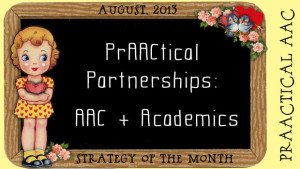
Like many of you, we are always racking our brains trying to help students who use AAC be successful academically. Because we serve these students in a clinical setting, we could easily pass on the opportunity to align our AAC goals with academic standards but what would be the fun in that? Here are some things we try to think about with school-aged kids who have AAC needs. SLP to SLP If it takes a village to raise a child, how many people does it take to help a kids with AAC needs to develop communicative competence and succeed academically? It boggles the mind. As SLPs, message is this: We have to work together. Many kids who use AAC have private therapies in addition to their school services, and yet, we rarely connect. We have to find a way to do a better job at this so that kids with... [Read More...]
Filed under: Strategy of the Month
Tagged With: assessment, classroom, collaboration, education, testing
July 21, 2013
by Carole Zangari -
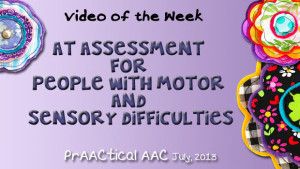
SLP Jane Korsten is well known to many as the author of the popular program, Every Move Counts, and for her leadership role in the Quality Indicators in AT group. This week, we feature Jane’s webinar on assessment in AT hosted bythe Maryland AT Network, the Maryland State Department of Education, and Johns Hopkins University. She discusses several helpful resources and reviews 6 assessment processes used in the AT assessment of individuals with motor and sensory impairments.
Filed under: Video of the Week
Tagged With: assessment, Clicks and Chats, Every Move Counts, Jane korsten, QIAT
June 1, 2013
by Carole Zangari -
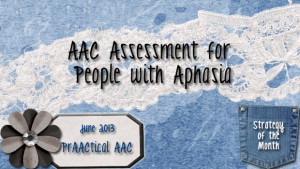
Many people with aphasia fail to regain sufficient speech and language skills to meet their communication needs. With more than one million people with aphasia in the US alone, chances are most people reading this know at least one person affected by the disorder. While many go on to regain functional speech and language skills, some remain unable to communicate well enough catch up with a neighbor, talk about bills with a spouse, ask a question in a store, play with a grandchild, or tell their healthcare providers about side effects or symptoms. It’s hard to really imagine how devastating and isolating this experience may be. Aphasia Awareness Month seemed like the perfect time to reach out to SLPs with information on AAC for people with aphasia. In this post, we’ll share some thoughts and resources on assessment. Assessment activities are, of course, driven by the purpose for which the... [Read More...]
Filed under: Strategy of the Month
Tagged With: aphasia, assessment, Joanne Lasker, Kathryn Garrett, MCST-A
May 27, 2013
by Carole Zangari -
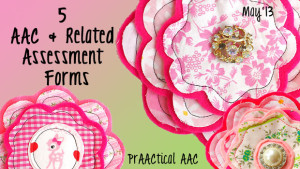
Ask any 10 professionals how they do AAC evaluations and you’re likely to get 10 different answers. We look for the same things (I think!) but go about it in different ways. We’re always happy to take a look at the protocols and forms that our colleagues develop and/or use. Here are some that might be of interest. 1. Bloom and Lahey Recording Sheet for staging language by Sherri Vernelso and Emily Pratt 2. Kate Ahern’s form for AAC device trials 3. SETT process assessment forms by HILIA Coordinators of Assistive Technology Services 4. The Functional Behavior Assessment Worksheet and Observation Forms by PaTTAN 5. Assessing the metaphoric use of pictures (e.g., Minspeak, Unity) protocol and forms by Gail Van Tatenhove If you have a protocol or form that you’d like to share, please get in touch. We’re always looking for new and better tools.
Filed under: PrAACtical Thinking
Tagged With: assessment, evaluation, forms, resources, testing
March 17, 2013
by Carole Zangari -
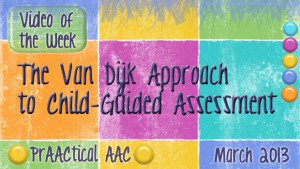
Getting good assessment information on learners with multiple disabilities, hearing, and vision loss is difficult, to say the least. Today we travel to the Netherlands to learn from Dr. Jan Van Dijk, who has pioneered an approach to working with individuals who have deafblindness. This series of webcasts, produced by Perkins School, discusses the theoretical underpinnings and practical aspects of the Van Dijk approach to child-guided assessment.
Filed under: Video of the Week
Tagged With: assessment, deafblind, hearing loss, multiple disabilities, Van Dijk, vision loss
March 16, 2013
by Carole Zangari -
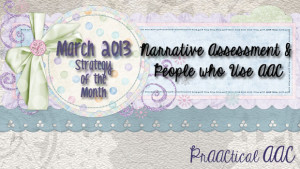
This month, we’ve been talking about building narrative skills in our AAC clients. We tried to build the case that including narrative language goals in our intervention allows us to help people who use AAC to participate more fully in social exchanges, relay more in-depth information, and achieve greater academic success. But how do we know where to start in narrative intervention? And how do we measure progress? In this post, we share some thoughts on the assessment of narrative language in AAC. Most test batteries that assess narrative language are designed to take a snapshot of what the learner has already mastered in terms of telling personal narratives, story retelling, or scripts. This allows us to look beyond MLU, morphology, and grammar and can be useful in determining whether intervention is needed. Some scholars, however, have noted the limitations of this “one shot” approach, particularly for learners whose communication... [Read More...]
Filed under: Strategy of the Month
Tagged With: analysis, assessment, narrative language, Scripts, stories, story grammar
December 7, 2012
by Carole Zangari -

Last month, we talked a lot about semantic intervention with people who are learning AAC. Once we got started, we realized we could have done another whole month on the topic, but we had to move on. We ran out of time before we could really talk about outcome measures. As clinicians, how do we determine whether our therapy is effective? Here are some things to do after you’ve provided high-quality, well-sequenced vocabulary instruction. Make small comprehension checks a regular part of your instruction. Ask the AAC learner to tell you about ___ . Then score their response as objectively as possible (e.g., complete & correct, correct but incomplete, vague, incorrect). You’ll get some real-time feedback and can clarify or re-teach as necessary. Assess in a standardized fashion. Standardized means doing something the same way each time. Set up appropriate assessment tasks that allow you to judge how well the... [Read More...]
Filed under: PrAACtical Thinking
Tagged With: assessment, data, data-based decisions, semantics, vocabulary
November 29, 2012
by Carole Zangari -
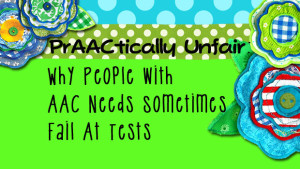
What do these situations have in common? Renting a car with a new GPS system to drive to an interview in a foreign city Hosting a dinner party and cooking a gourmet meal in someone else’s kitchen Using new software to deliver a presentation at a conference If you said they all create anxiety, you’re right. But here’s something else: They all require you to do something unfamiliar or difficult and learn a new tool at the same time and produce results under stressful conditions. We would never put our AAC learners under such stress and expect them to perform well, would we? Of course not! Except when we: Ask them to use an AAC device/app that they are still learning to answer test questions Require them to use a new or exhausting motor pattern to produce a written product for grading Expect students without sufficient test-taking skills to demonstrate... [Read More...]
Filed under: PrAACtical Thinking
Tagged With: assessment, Fair Testing Practices, FTP, testing
August 24, 2012
by Carole Zangari -

We loved it as a computer program and now we love it as an app. 1. The AAC Evaluation Genie app covers a lot of ground, starting with simple discrimination tasks all the way up through word prediction. 2. It helps keep us organized and focused in the app portion of the assessment process: The way the assessment activities are laid out helps us move beyond picture identification in a organized fashion. 3. It allows for a lot of flexibility. How many times have you done an AAC evaluation where you prepared for a client with a certain set of skills, only to find yourself face-to-face with someone whose skills are way above or below what you planned for? It ’s great when you have a tool that will let you move easily to another set of tasks when the need arises. 4. It accommodates both direct selection and scanning. 5.... [Read More...]
Filed under: PrAACtical Thinking
Tagged With: AAC Evaluation Genie, Apps, assessment
August 23, 2012
by Carole Zangari -
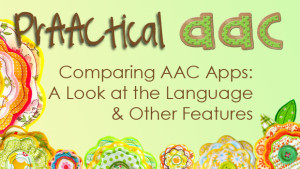
Well, the school year is all of 3 days old and already we’ve had plenty of questions about AAC apps. Sigh. We’ve had our ups and downs with AAC on mobile devices, but there is no sense rehashing all of that here. Instead, we’ll focus on some of the tools we use when helping to determine which, if any, are a good fit for a particular communicator. AAC App Lists: Comprehensive AAC app list for iPhone and iPad by Jane Farrall Feature Match Checklists & Forms: Jessica Gosnell at Boston Children’s Hospital Scott Marfilius and Kelly Fonner Our Rubric for Evaluating the Language Aspects of the AAC App RELAACs Other Helpful Sources Scoop.It collection and Pinterest boards with AAC app sites and videos OCALI’s listing of apps for individuals with ASD Tech Connect’s Apps Assistant The App Academy’s site for app training videos
Filed under: PrAACtical Thinking
Tagged With: Apps, assessment, checklist, feature match, resources, rubric









